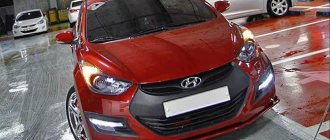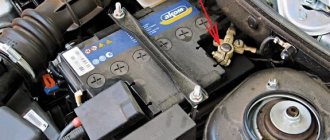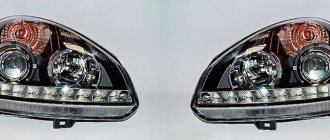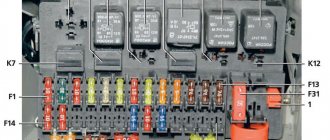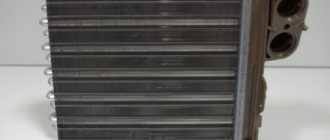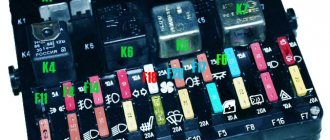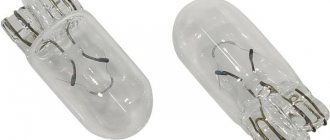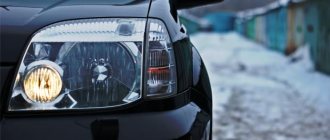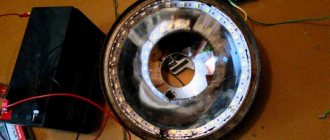Automatic DRL controller
Author: CAMOKAT-BETEPAHA Published 07/30/2013 Created with the help of KotoEd.
The controller controls the inclusion of DRLs when necessary. This is the main task, although it can be applied in other areas. The signal for turning it on and off is the voltage of the on-board network and also the signal from the vehicle’s dimensions.
The controller has the ability to adjust the threshold for turning on and off the DRLs, and it is also possible to configure not the complete extinction of the DRLs when the lights are turned on, but the choice of any brightness level of the DRLs from zero to maximum.
The controller has smooth ignition and smooth decay.
The setup algorithm is simple:
There are two control buttons: “Minimum” and “Maximum”. With the engine off and the generator not running, press the “Minimum” button. The controller remembers the minimum voltage value. Next, the engine needs to be started, the generator starts working, the voltage in the on-board network increases - press the “Maximum” button. All setup is complete. Now the controller monitors the voltage of the on-board network, and if the voltage exceeds two-thirds of the minimum-maximum difference, then the DRLs will work. In order for the DRLs to go off, the voltage must drop below one-third.
If the headlights are turned on and the DRL operation is enabled, the brightness will change to the level to which the brightness level control potentiometer is turned. You can make sure that when you turn on the DRLs they go out completely, or you can adjust a third of the brightness, for example, or any other brightness level.
To connect the controller, you need to connect four wires: ground, + ignition, dimensions and output to DRL.
There are three operating modes: 1. — Main mode, when switching on occurs at 2/3 of the voltage, and switching off at 1/3 of the on-board network voltage. As described above in the link. The operating condition for this mode is that the minimum threshold must be higher than the maximum. That is, they turned on the ignition, pressed the MIN button, then started the car - pressed the MAX button.
2 — Selected threshold mode without a hysteresis loop, as in the first version of operation. The condition for selecting this mode: you need to press two buttons at the same time, after which the voltage on board the network at which the setting buttons were pressed will be considered the threshold. Exceeding this threshold above immediately turns on the light, below - turns it off.
3. — Fixed threshold mode at 13.8 Volts. The condition for selecting this mode: you need to do the opposite, press the MIN button when the engine is running, and the MAX button when the engine is off. In other words, the maximum threshold value must be less than the minimum.
The result is a fairly universal craft, which can, for example, be used to control a generator or control the excess of any voltage somewhere or, conversely, its decrease.
Attached is the firmware, diagrams and everything you need for assembly, a list of components, including sources:
Hello, dear friends! I think many people are interested in an effective connection diagram for DRLs, that is, daytime running lights.
For several years now, there have been rules in the country according to which, when driving a car during the day, you should indicate your presence with the help of appropriate headlights. Fog lights, low beam headlights and the DRLs themselves are used as such lamps.
The use of fog lights and headlights has objective disadvantages. Therefore, it is best to connect the DRLs from the generator or battery yourself.
There are various ways and schemes for implementing the idea. Some do this without a relay, others combine DRLs with turn signals, others even control the daytime lights with a separate button, etc. To do everything right, you need to know some important points. And then automatic activation will be carried out without violating traffic rules.
Nuances of using lights
There is a special GOST that defines and regulates installations, technical parameters and the connection itself of daytime running gears.
The regulations state that the circuit should be used in such a way that the drive wheels turn on automatically when the key is turned in the ignition switch. That is, when starting the power plant. But DRLs are also required to turn off automatically as soon as the main beam headlights come on. Here, as you understand, we are talking about the headlight unit (low or high beam). There is also a rule indicating that the head light should turn on only when the headlights turn on. The exception is short-term signals to warn other drivers.
Based on the above, we can safely say that you should not output the DRL through the button. The same as through the handbrake. But you can install it in turn signals, but you will need to connect 2 additional wires from each turn signal.
All this is extremely important to take into account when connecting the movers. After all, you should be concerned not only with the fact that the light bulbs do not burn out. Although this is an extremely significant point.
Without a well-thought-out and competent scheme, you will definitely not be able to install DRLs yourself. After all, everything should work with a shutdown when the high or low beam is turned on.
There are a number of schemes according to which, in theory, you can install DRLs on your car if they are not included in the standard configuration of your vehicle. The only question is which scheme is better to use.
An important role is played by the voltage stabilizer, which is a subject of much debate when using diode running lights. The DRLs themselves are equipped with resistors that act as a current limiter. But during voltage surges, they are not able to maintain the voltage at a single level. Therefore, it is correct to assume that the use of a stabilizer in such a scheme will be mandatory and necessary. Otherwise, the service life of the DRL will be significantly reduced due to regular voltage drops. Although some still believe that the connection can be made without a stabilizer.
What tools will you need?
Headlights play an important role in the design of LADA Priora. Therefore, when removing a headlight for its subsequent replacement, it is necessary to know well the sequence of disassembly and assembly of the structure. To remove the headlight block on a Priora, many go to a service station. However, this procedure is so simple that if you have certain tools, you can handle this task yourself.
In this case, the following tools will be required for work:
- wrench 8 or 10 mm;
- ratchet;
- a screwdriver with a cross-shaped blade;
- extension.
It couldn't be simpler
This is the simplest scheme, which involves connecting to a battery or generator as a power source.
The scheme provides that the DRLs will be activated simultaneously with the engine starting. The point is to connect the plus to the positive terminal from the ignition switch of your Renault Logan or the same Lada Largus, and fix the minus on the car body in any convenient place. Everything looks simple and extremely logical. But you should not rush to conclusions, nor should you make such a connection. After all, it has an obvious drawback.
If the system is assembled according to this scheme, the diodes from the DRLs will start working constantly while the key is in the ignition switch. There is no question of any coordination with other headlights here. Therefore, such a connection contradicts GOST and traffic regulations.
Requirements according to the regulations
The new travel requirements regulate the use of either low beam headlights or DRLs, if any, during daylight hours. The use of running lights allows you to extend the life of light sources in car headlights. They also allow you to save battery power or fuel, which is consumed when the headlights are low beam.
The diodes themselves shine in all directions, or rather 120 degrees. To solve this problem, light is focused using optics, mainly lenses. To determine the lens parameters, you need to determine the power, which is measured in Lumens. However, to evaluate performance efficiency, light intensity is measured not in Lumens, but in Candelas. To measure the light intensity of the DRL, you need to place a lux meter in front of the diode at a distance of one meter. In this case, Luxes are converted to Candelas.
Required characteristics for DRL:
- 500 – 700 lumens in each running light;
- power must be at least 6 watts;
- The lighting angle should be 35 degrees.
In addition, DRLs must meet the requirements according to GOST:
- luminous intensity – 400 – 800 Candelas;
- the glow angle should be 25 degrees vertically and 55 degrees horizontally;
- the illuminated area of each of the lights is at least 40 square centimeters;
- light sources should be located at a distance of 25 centimeters from the road surface;
- the distance between the running lights must be at least 60 centimeters;
- The permitted colors of lights are yellow or white.
Low beam or dimensions
You can also connect to the side lights or low beam headlights. In theory, everything here also looks quite simple, interesting and promising.
The first of the schemes under consideration provides that you will use an electrical circuit that powers the size lamps. Here the plus from the DRL is connected directly to the battery as a power source. But the minus goes to the plus of the dimensions. At such a moment the latter will be electrically neutral. Thus, the current flows from the plus of the battery through the diodes to the dimensions, and then through the lamp to the housing, where the latter acts as a minus of the created electrical circuit.
Since the level of current consumption will be small, the diodes will start to work, but the size lamp will not turn on.
As soon as the driver switches to the dimensions, a voltage of 12V will appear on its positive side, the potentials will be equalized on the DRL wiring and the diodes will go out. The circuit will begin to operate in normal mode, supplying current to the dimensions.
Everything seems to be fine. But again, conclusions were drawn hastily.
The scheme is simple and working. It just has a few drawbacks:
- The drive trains will remain active when the engine is switched off. This directly contradicts current laws;
- If the dimensions are equipped with LED lamps, such a circuit will immediately become inoperative;
- Operation will not be correct when using powerful SMD diodes as part of DRLs;
- To provide additional safety, you will have to add a fuse to the circuit.
To avoid the first drawback, the circuit is slightly altered. The positive from the LED module is taken not from the positive of the battery, but through the positive of the ignition switch.
The second scheme involves activating the DRL using a low beam lamp. The point is that when the low beam is turned on, the walkers are turned off, and the rest of the time they work.
There are the same disadvantages here as for the previous scheme. That is, it contradicts GOST and traffic rules.
LED lamps and the law in
The main regulatory framework has not changed: 12.5 of the Code of Administrative Offenses of the Russian Federation, part 1,2,3, 12.20 of the Code of Administrative Offenses of the Russian Federation, TR CU 018/2011 clause 77, Traffic Regulations, clauses 19.6, 3.7 and 3.8 of the Code of Administrative Offenses of the Russian Federation.
LED lamps are installed in standard headlight locations instead of halogen lamps. It is quite difficult to notice the replacement with an LED when the light is correctly adjusted.
Lamps must have a certificate from the manufacturer that this lighting device has all acceptable characteristics. LED is not xenon and is classified according to 2.5 Code of Administrative Offenses of the Russian Federation, part 1 with a fine of 500 rubles. A fine is issued only at the initiative of the inspector (in rare cases). There is no legislative framework for LED with deprivation of rights. When drawing up a protocol, be sure to record the color of the glow and the certificate of conformity of the lamps, then any Resolution under 12.5 Part 3 of the Code of Administrative Offenses regarding LEDs can be challenged.
The condition for a quiet ride is a correctly adjusted light with a glow color that is not prohibited by traffic regulations.
I will quote once again the Russian Traffic Regulations “Appendix. List of malfunctions and conditions under which the operation of vehicles is prohibited:
Don't use over-powered bulbs, adjust your headlights, and be respectful of other drivers on the road at night.
8(800) 350-34-54
4 pin relay, generator and oil sensor
These are two more methods worth considering. A 4-pin relay, a generator and an oil pressure sensor will be used here. But not in a single chain.
Both schemes assume that the DRLs will turn on only when the engine starts. The system is powered by a generator and is based on switching a 4-pin switch and a reed switch.
The connection of the relay contacts looks like this:
- Pin 30 goes to the plus of the LED module;
- Contact 85 goes to the plus of the wire to the dimensions;
- Contact 86 is required for any output from the reed switch;
- 87 contact to the positive terminal from the battery;
- Also, the second terminal from the reed switch goes to the battery plus.
After connection, configuration must be carried out. Here you need to start the engine and start moving the reed switch near the generator in order to get the movement and stable operation of the movers. Then the reed switch should be removed into a special thermal tube and fixed.
If there is no reed switch, then power for the DRL can be supplied through the oil pressure sensor. Then contact 86 goes to the pressure lamp, but otherwise the circuit remains in its original form.
The schemes are excellent in many ways. But they cannot be used in situations where the dimensions are based on LEDs. This is the only significant drawback.
Connection diagrams for DRLs with turn signal function
There is no single scheme suitable for all car models, since their designs are different. And the blocks themselves are also different. Therefore, it is best to look at forums where owners of a particular model communicate; there, most likely, you will find many connection options, and tested in practice.
For example, you can use the following schemes:
- connection to the cigarette lighter, if power is supplied to it when the engine is turned on. This will ensure that the running lights turn on at the same time. This is suitable, for example, for Dusters;
- connection to the speed sensor. Switching on will occur when you start driving, and switching off when stopping;
- connection to the oil sensor. Switching on will occur when the engine starts;
- connection to the generator.
All these are common schemes that are assembled with your own hands. There are many others like this. They are suitable for those who like to make and solder various devices themselves.
But how to connect DRLs with a turn signal function from a ready-made kit? This is the simplest option, anyone who knows how to hold a screwdriver can handle it, but it will take a master a few minutes. The control unit is connected simply:
- the black wire is connected to the negative of the battery, and the red wire to the positive;
- The orange wire connects to the headlights or low beam. It is needed to turn off the lights when the low beam or side lights are turned on. This wire is not always available.
If the DRL bulbs and the turn signal are structurally located in the same lamp, they still have different contacts that are connected according to the attached diagram.
Control block
The simplest and most reliable connection method is the use of a control unit and the abandonment of a relay. This is a fully thought-out unit that does not require any complex manipulations.
But the big problem is that most often motorists come across a Chinese controller. They do not comply with GOST and have low build quality.
If you use control units, then only these:
These manufacturers have proven themselves to be excellent, and the units they offer really work efficiently and effectively. Moreover, the first one on the list is a domestically produced solution.
The second two blocks are German, sold complete with DRLs, and therefore cost significantly more.
How do you solve the problem with connecting DRLs, which have actually become a mandatory element?
Thank you for your attention! Subscribe, leave comments and ask your questions!
( 8 ratings, average: 4.50 out of 5)
On the territory of the Russian Federation, amendments to the rules of the road (TRAF) have been in force for more than 8 years, according to which a moving vehicle during daylight hours must be indicated by low beam headlights, fog lights (FTL) or daytime running lights (DRL). Using headlights and fog lights for these purposes has a number of disadvantages. Therefore, drivers prefer to buy ready-made running light modules and install them in their cars themselves. How to properly connect daytime running lights so that their operation is safe and does not contradict current laws?
Choosing DRLs for Lada Largus
In the case when the Lada Largus is not equipped with DRLs at the factory, they can be installed using two methods:
- Contact a specialized service station.
- Install with your calloused hands.
Lada Largus, which was equipped with DRLs
Your choice should be on reliable DRL models. Parts from China will cost less, but European lights will last longer . Here you need to choose depending on your wallet. Experts note that high-quality domestically produced lights are quite difficult to find.
Factory version according to GOST
The most reliable and most expensive! The original kit from dealers will cost at least 5,000 rubles.
It includes:
- Lamps for fog lamps (2 pieces).
Replacing standard trims with PTF with DRL
Original DRL control unit
Connection diagram
DRL connection diagram for Largus
Ordinary lamps from CHINA
Option for installing DRL lights in fog lamp covers
The cheapest and most unreliable option. But the cost of 250 rubles is very tempting.
The installation of such DRLs is as simple as possible - they are simple, the positive wire is thrown to the ignition (in the relay), the negative wire is connected to the ground of the car.
The easiest to install DRL option on Largus
Installing factory daytime running lights
If you have at least basic skills and knowledge of the car’s electrical system, then you can do the work of installing DRLs on your own. The work will take no more than an hour.
If the lights were purchased in a store, then installing them will not be difficult. The kit includes instructions for their installation, and therefore all actions should be performed according to the rules described there. If any difficulties arise in this, you should contact the service station.
Algorithm
- We install the DRL ignition unit under the hood.
We carefully attach the ignition unit under the hood
For reliability, check the voltage on the block in the relay when turning on the ignition
Homemade daytime lights
Those who do not want to spend money on purchasing factory DRLs can make them themselves, following these recommendations:
- You need to prepare the wires, LED strip and plugs for the headlights.
- The tape should be cut to the required sizes.
- Holes for the strips are drilled on the plug.
- The wires are soldered to the strips.
- The strips themselves are attached to the plugs.
- The wires are being connected in the engine compartment.
- The wires can be connected to the fuel pump relay. In this case, the lights will light up automatically when the ignition is turned on.
The nuances of turning on running lights
The basic requirements regarding installation, technical parameters and connection of navigation lights are listed in paragraph 6.19 of GOST R 41.48-2004. In particular, the electrical functional circuit of the DRL must be assembled in such a way that the running lights turn on automatically when the ignition key is turned (the engine starts). In this case, they should automatically turn off if the headlights are turned on.
Clause 5.12 of this standard states that headlights (FGS) should be turned on only after the lights are turned on, with the exception of short-term warning signals. When connecting DRLs yourself, this feature must be taken into account.
Correct connection of DRLs is not limited to a well-thought-out functional diagram. It's time to think about the stabilization unit for LEDs. In the running lights themselves, resistors act as a current limiter; however, due to voltage drops, resistors cannot limit the current to the same level. That is why a voltage stabilizer in the running lights connection circuit is extremely necessary. Otherwise, the service life of LED DRL modules is significantly reduced due to constant changes in on-board voltage. Some car enthusiasts claim that it is possible to connect running lights without a stabilizer.
Connecting and installing an LED driver is a waste of time, because the DRLs on LEDs shine regularly for months without any stabilization...
However, this statement is easy to dispute. The fact is that with each voltage surge, more than 12 V appears on the LED module, the forward current through the LEDs exceeds the nominal value, which leads to overheating of the emitting crystal. The brightness of the LEDs decreases, such DRLs will no longer be able to fulfill their immediate task - to warn oncoming drivers from afar, and over time they will begin to flicker and fail.
Using LED DRLs without a voltage stabilizer means spending at least several hundred rubles every year on new modules and wasting time replacing them.
For ease of understanding, the circuits below are shown without using a stabilizer.
A little theory
Stable salary, stable life, stable state. The last one is not about Russia, of course :-). If you look in an explanatory dictionary, you can clearly understand what “stability” is. On the first lines, Yandex immediately gave me the designation of this word: stable - this means constant, stable, not changing.
But most often this term is used in electronics and electrical engineering. In electronics, constant values of a parameter are very important. This can be current strength, voltage, signal frequency and other characteristics. Deviation of the signal from any given parameter can lead to incorrect operation of electronic equipment and even to its breakdown
Therefore, in electronics it is very important that everything works stably and does not fail.
In electronics and electrical engineering, voltage is stabilized. The operation of electronic equipment depends on the voltage value. If it changes to a lesser extent, or even worse, to an increase, then the equipment in the first case may not work correctly, and in the second case it may even burst into flames.
In order to prevent voltage spikes and drops, various voltage stabilizers were invented. As you understand from the phrase, they are used to stabilize the “playing” voltage.
Switching on through dimensions or low beam
The second version of the DRL connection diagram involves using the power circuit of the side light bulb. To do this, the positive wire from the running lights is directly connected to the “+” from the battery. In turn, the negative wire is connected to the “+” of the side light, which is currently electrically neutral. As a result, the following current flow path is formed: from the “+” of the battery through the LEDs to the size, and then through the light bulb to the body, which serves as the minus of the entire circuit. Due to the low current consumption (tens of mA), the LEDs begin to glow, and the lamp spiral remains extinguished. If the driver turns on the side lights, then +12 V appears on the positive side of the side lights, the potentials on the DRL wires are equalized and the LEDs go out. The circuit goes into normal mode, that is, current flows through the side light bulbs.
This circuit solution has several disadvantages:
- running lights remain on when the engine is turned off, which is contrary to current regulations;
- the circuit will not work if LEDs are also installed in the dimensions;
- the circuit will not work correctly if the DRLs contain powerful SMD LEDs, the rated current of which is comparable to the current of a light bulb;
- For safety reasons, an additional fuse must be installed.
What are the main characteristics of LEDs?
When choosing such elements for a particular purpose, everyone pays attention to their technical data. The main things you should pay attention to when purchasing devices based on them:
- consumption current;
- Rated voltage;
- power consumption;
- color temperature;
- luminous flux strength.
This is what we can see on the labeling of LED lamps. In fact, there are much more characteristics. Let's talk about them now.
LED current consumption - what is it?
The LED consumption current is 0.02 A. But this only applies to elements with one crystal. There are also more powerful light diodes, which can contain 2, 3 or even 4 crystals. In this case, the current consumption will increase, a multiple of the number of chips. It is this parameter that dictates the need to select a resistor that is soldered at the input. In this case, the LED resistance prevents the high current from instantly burning the LED element. This may happen due to high mains current.
RGB spotlights with controller and remote control are really good
Rated voltage
The voltage of an LED is directly dependent on its color. This happens due to the difference in the materials used to make them. Let's consider this dependence.
| LED color | Material | Forward voltage at 20 mA | |
| Typical value (V) | Range (V) | ||
| IR | GaAs, GaAlAs | 1,2 | 1,1-1,6 |
| Red | GaAsP, GaP, AlInGaP | 2,0 | 1,5-2,6 |
| Orange | GaAsP, GaP, AlGaInP | 2,0 | 1,7-2,8 |
| Yellow | GaAsP, AlInGaP, GaP | 2,0 | 1,7-2,5 |
| Green | GaP, InGaN | 2,2 | 1,7-4,0 |
| Blue | ZnSe, InGaN | 3,6 | 3,2-4,5 |
| White | Blue/UV diode with phosphor | 3,6 | 2,7-4,3 |
Light diode resistance
The same LED itself can have different resistance. It changes depending on its inclusion in the circuit. In one direction - about 1 kOhm, in the other - several MOhms. But there is a nuance here. LED resistance is nonlinear. This means that it can change depending on the voltage applied to it. The higher the voltage, the lower the resistance will be.
Spot ceiling light with diodes is very economical
Light output and beam angle
The angle of the luminous flux of LEDs may vary, depending on their shape and material of manufacture. It cannot exceed 120. For this reason, if greater dispersion is required, special reflectors and lenses are used. This quality of “directional light” contributes to the greatest luminous flux, which can reach 300-350 lm for one 3 W LED.
LED lamp power
LED power is a purely individual value. It can vary in the range from 0.5 to 3 W. It can be determined by Ohm's law P = I × U, where I is the current strength and U is the LED voltage.
Power is a fairly important indicator. Especially when it is necessary to calculate which power supply is needed for a particular number of elements.
Colorful temperature
This parameter is similar to other lamps. The closest temperature spectrum to LED fluorescent lamps is. Color temperature is measured in K (Kelvin). The glow can be warm (2700-3000K), neutral (3500-4000K) or cold (5700-7000K). In fact, there are many more shades; the main ones are listed here.
There can be hundreds of crystals on such a platform
LED element chip size
You won’t be able to measure this parameter yourself when purchasing, and now the dear reader will understand why. The most common sizes are 45x45 mil and 30x30 mil (corresponding to 1 W), 24x40 mil (0.75 W) and 24x24 mil (0.5 W). If we translate into a more familiar measurement system, then 30x30 mil will be equal to 0.762x0.762mm.
There can be many chips (crystals) in one LED. If the element does not have a phosphor layer (RGB - color), then the number of crystals can be counted.
Important! You should not buy very cheap LEDs made in China. They may not only be of poor quality, but their characteristics are most often overstated. It is quite difficult to distinguish a fake from the original when purchasing
Connection via a 4-pin relay from a generator or oil sensor
The following two methods have a common basis and imply the operation of daytime running lights only after the engine is started. The circuit for switching on DRL from the generator is based on switching a four-contact relay and a reed switch.
The DRL relay contacts are connected as follows:
- 30 – to the positive terminals of LED modules;
- 85 – to the positive wire to the dimensions;
- 86 – to any reed switch output;
- 87 and the second terminal of the reed switch - to the “+” of the battery.
After checking the reliability of all contacts, proceed to setup. To do this, start the engine and, by moving the reed switch near the generator, achieve its activation and a stable glow of the DRL. Then the reed switch is hidden in a thermal tube and fixed in the found place using nylon ties.
At the moment of starting the engine, and then the generator, the contacts of the reed switch and relay close, supplying power to the LED running lights. In this case, the side lamps remain turned off, since the current through the relay coil is small to light them.
In the absence of a reed switch, you can power the DRL from the oil pressure sensor. In this case, pin 86 is connected to the oil pressure lamp. The rest of the circuitry is duplicated.
Both schemes have a common drawback. They cannot be used if LEDs are installed in the dimensions.
Useful video
You can see some options for installing and connecting the DRL in the video below:
Many car enthusiasts have not yet installed daytime running lights on their car, but perhaps they have been thinking about it for a long time. It's no secret that the absence of running lights, as well as the low beam/fog lights being turned off, can cause your vehicle to be stopped by a vigilant traffic police inspector, which is not very desirable for most drivers, unless the latter lack communication with people and are happy any company at any time.
In addition, if you use low beam or fog lights as daytime running lights (hereinafter referred to as DRLs), you will probably have to change the lamps in these headlights much more often. There is also the issue of increased gas consumption when constantly driving with the low beams on. Of course, this expense is negligible compared to the main one, but it still occurs.
If you have a certain amount of time (depending on skills and experience) and desire, correctly installing DRLs on a car is not such a difficult task for people who know how to hold a soldering iron in their hands and crimp terminals with wires, and in this article I will tell you how to do this .
Of the tools and materials we will need: a crimping device (if you have some skill, pliers will also do), a soldering iron, wire cutters, a knife, a lighter (as an option for tightening the heat-shrink tube), 3-4 meters of two-core wire in PVA insulation 2x1.5 (2x0 is possible .75 if the DRLs are LED and not the fog lights with halogens!). This wire will be needed to connect two lamps in parallel with each other.
You will need a standard 12 V automotive relay, four-pin, reed switch (any), single wire with a diameter of 1.5 to 2.5 mm. approximately 2-3 m., plastic clamps, heat shrinkage. That seems to be all.
Now a few words about connection options.
Option 1.
You can make the DRLs turn on when you turn on the ignition and not turn off until the engine is turned off. This is the simplest option. The negative wire is attached to the car body in any convenient place, the positive wire is attached to the positive wire from the ignition switch or to terminal D of the high-voltage module, preferably through a fuse (not indicated on the diagram).
Option 2.
The same option, but when the low beam is turned on, the DRLs go out. In this case, we connect the plus in the same way as in the first option, and the minus – to the positive wire of the low beam lamp (either of the two). The fact is that an incandescent lamp consumes much more current and has a much lower resistance than LED DRLs and therefore, when the DRLs are turned on in this way, the lamp filament will not heat up even to the minimum glow at full incandescence, and when the DRL is operating, the resistance of the lamp filament is ( even warmed up) will have practically no effect.
As soon as you turn on the low beam, a plus will appear on the negative side of the DRLs and they will go out. True, if you turn on the high beam, the DRLs will light up again. In this case, you can connect the DRLs to the side lamps in the same way (if incandescent lamps are used as such, and not LED!). In most cars I know, the side lamps are a priori connected in parallel, so you can connect the common negative wire from two DRL lamps to any side lamp.
Option 3.
This is an option where the DRLs turn on automatically only when the engine is started and running. In this case, we also connect the minus of the DRL to the car body, and the plus to the 30th contact of the relay. Contact 87 is connected to the more powerful positive (you can connect to the positive terminal of the battery), contact 85 of the relay is connected to the vehicle ground through the running lights, and 86 is connected to the reed switch, to one of its terminals.
We also connect the second output of the reed switch to any plus nearby (can be from the generator or from the same place - from the battery). We start the car and by moving the reed switch around the generator we achieve the relay activation and the DRL ignition. We attach the reed switch, pre-packaged in heat shrink, using a plastic clamp to the generator in the found position and you’re done.
Option 4.
If there is no reed switch. Everything is the same, only contact 86 goes to the oil pressure lamp in the instrument panel.
That's all. In conclusion, I will say that using something made with your own hands is much more pleasant than something made by others. Good luck in implementing your and not yours, but most importantly, interesting ideas.
– these are lighting devices installed on a car and intended for use during daylight hours to improve the visibility of the vehicle while driving. DRLs can be provided by the manufacturer or installed additionally.
Daytime running lights on the VAZ-2114 are not provided by the manufacturer, therefore, if there is such a need, they can be installed additionally.
Connection via 5-pin relay
Now it's time to learn how to connect running lights via a five-pin relay. The scheme is the most universal, and was assembled to eliminate the disadvantages of previous options. First, about connecting the relay for DRLs:
- 30 – to the positive terminals of LED modules;
- 85 – to the positive wire of the side lamp;
- 86 – on the car body;
- 87a – to “+” from the ignition switch;
- 87 – do not connect (isolate).
The circuit with a five-contact relay works as follows. When you turn the key, +12 V is supplied to the DRLs, thereby turning them on. If you turn on the side lights or headlights, the relay will open contact 87a and close inactive contact 87. As a result, the DRLs will go out and the side lights will turn on. The circuit fully complies with the requirements of GOST and traffic regulations and can work with side lights even based on LEDs.
However, the circuit still has one negative point - the DRLs will turn on immediately after turning the ignition switch. That is, if you turn the key in the ignition but do not start the car, the DRLs will light up.
Despite the existing drawback, the circuit is quite successful, but in order to correctly connect the DRL via a five-pin relay, you will need to supplement the circuit with a voltage stabilizer.
This switching option is interesting because the path of current flow through the running lights is independent. This allows you to install light sources of any type and power in headlights and DRLs.
Types of DRL controllers
In most cases (about 95% of cars), the headlight bulbs are turned on with positive voltage. This explains such a variety of “plus” controllers. However, some manufacturers use “minus” control - in this case, a “minus” controller is used when connecting.
Appearance of DRL controllers
The brightness of the lamps for DRL controller 'a and DRL 2+ controller 'a is regulated by a trimming resistor on the back of the housing.
All settings of Max DRL 2+/- controllers and Start-Stop 3-in-1 devices (in DRL mode) are changed by a pulse sequence at the “Dimensions” input (by the size switch after connecting to the car).
The simplest one - Lite DRL controller - does not have adjustable settings.
You can evaluate the capabilities of the controllers using the table below. More detailed information can be found on the product description page for the relevant device.
Installation
There are several basic ways to make DRLs on your car. If it's just replacing old ones with new ones, then there are minimal problems. Everything is mounted the same way as in the old scheme.
If LED daytime running lights are installed on a car for the first time, you can go this route.
- Installation on mounting brackets. They are located on the sides of the DRLs. The brackets have holes to secure the device with self-tapping screws. They are adjustable for reach and inclination, allowing you to place them equally and neatly;
- Mounting panel. The panel is first mounted into the free cavity of the front bumper, and the headlights themselves are snapped into place;
- On tape. Use double-sided tape. Installation is simple, but short-lived. DRLs can fly off at any time;
- Bumper cutout. And they cut it in two ways. The first is used when there are DRLs with separate LED modules. They are connected according to the principle of a garland. Each module has its own hole. The second option is for a solid body with a slight bend to follow the contours of the bumper. Only one hole is needed;
- Combination. This is a special, but expensive set of optics, which includes DRLs and fog lights, or daytime running lights with turn signals.
Think about what kind of daytime lights you should buy and how to include them in the optics so that they work efficiently and in accordance with all standards. If your DRLs don't light up as the law says, you'll get a fine.
Watch this video on YouTube
Write your opinion about DRLs and the relevance of their purchase if it is possible to use fog lights or low beams. Subscribe, tell your friends about us and wait for new materials!
options
options However, there is no need to give up after reading all of the above, as there is a way out of this situation.
After all, it is not at all necessary to use beautifully designed headlights with LEDs as DRLs. For this purpose, legal light sources may well be used. Which ones are considered legal? Those that were installed at the manufacturer's factory or self-installed headlights in compliance with the tolerances available in the vehicle design. These, for example, include PTF (fog lights). They are either available on almost every car, or its design provides for their installation. To install them, you do not need to obtain installation permits, and, according to traffic regulations, they can be used as DRLs. This means that all that remains is to modify the fog lights in such a way that they turn on or off automatically, depending on whether the engine is running or not. At the same time, the function of the anti-fog headlights will remain.
